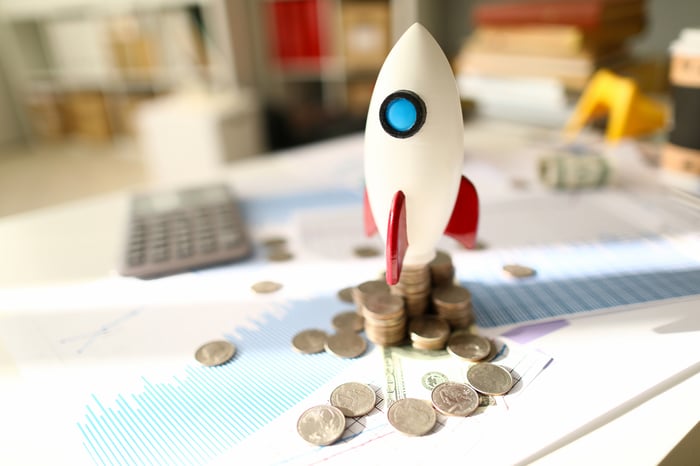For more than a century, the stock market has been one of the top wealth creators. The broad-based S&P 500 might not be the top-performing investment vehicle every year, but when compared to bonds, housing, and commodities, it's delivered superior average annual returns over the long run.
However, the return supremacy of the market has come under fire in recent years, thanks to the rise of cryptocurrencies like Dogecoin (DOGE 3.28%).

Image source: Getty Images.
The Dogecoin pump-and-dump is in its final stage
To cherry-pick the data a bit, Dogecoin returned greater than 27,000% between early November and early May, when Tesla CEO Elon Musk (aka the "Dogefather") hosted Saturday Night Live and made mention of the "people's currency," Dogecoin.
But since hitting a high of $0.7375 per token, the people's currency has imploded. On July 20, you could snag a single Dogecoin for a little over $0.16, which represents a decline of approximately 78% in just over 10 weeks. While you'll find no shortage of folks who believe this pullback is a buying opportunity, the more likely scenario is that the Dogecoin pump-and-dump has entered its final stage. In other words, it's game over for Dogecoin.
Although momentum has played a big role in driving cryptocurrency prices higher, the fact remains that Dogecoin never possessed any competitive advantages.
- It was never particularly inexpensive to complete transactions on Dogecoin's blockchain. There are well over a dozen popular cryptocurrencies that can complete transactions for a fraction of the total cost of a Dogecoin payment.
- Dogecoin's validation and settlement times were never that impressive. Quite a few of the digital currencies that offer significantly lower transaction fees than Dogecoin also validate and settle payments quicker, too.
- At its peak, Dogecoin can reportedly process 40 transactions per second. Meanwhile, payment processor Visa can handle 24,000 transactions per second. Based on the typical number of transactions being validated on Dogecoin's blockchain per day, it would take almost four decades for Dogecoin to do what Visa and Mastercard combine to do daily (about 700 million transactions).
- Dogecoin has never been widely accepted beyond cryptocurrency exchanges. It's taken eight years just for 1,400 mostly obscure companies worldwide to take Dogecoin as payment.
Long story short, Dogecoin isn't going to the moon. Sorry to disappoint its many "hodlers" and speculators.
Forget about Dogecoin: These stocks can go to the moon
However, just because Dogecoin isn't moon-bound doesn't mean there aren't stocks ready for takeoff. Opportunistic investors looking for stocks that could rocket to the moon, so to speak, should consider buying the following trio of high-growth companies.

Image source: Getty Images.
Cresco Labs
One of the more surefire investment opportunities this decade is U.S. marijuana stocks. Even if the federal government fails to pass any meaningful cannabis reform measures, the 36 states that have legalized weed in some capacity represents more than enough opportunity for the industry to generate tens of billions in annual sales. That's more than enough reason to believe Cresco Labs (CRLBF -1.37%) is ready to launch skyward.
Taking into account organic and inorganic growth, Cresco Labs has opened 33 dispensaries in legalized states, and will have closer to four dozen total dispensaries once its pending acquisitions close and all of its retail licenses are put to use. What's notable about Cresco's expansion strategy is that it's targeted a number of high-dollar markets (Florida), or markets where license issuance is limited (Illinois and Ohio). Pushing into markets where the number of retail licenses is capped in aggregate, as well as by business, will ensure that Cresco is given every opportunity to build up its brand and gobble up market share.
But let's be honest, investors are going to be far more excited about Cresco's industry-leading wholesale operations. Despite wholesale cannabis generating lower margins than retail, Cresco offers more than enough volume to make this margin difference irrelevant. That's because it possesses a cannabis distribution license in California, which it obtained via its acquisition of Origin House, in January 2020. This license allows Cresco to place proprietary and third-party pot products into more than 575 dispensaries throughout the Golden State (i.e., the top-selling weed market in the world).
Between retail and wholesale, Cresco should be one of the fastest-growing pot stocks of the decade.

Image source: Getty Images.
PubMatic
Another stock that has the potential to moonshot while Dogecoin continues to sink is advertising technology company PubMatic (PUBM 1.81%).
Since the internet became mainstream over a quarter of a century ago, we've watched the highly inefficient human element of ad pricing go out the window in favor of programmatic advertising. Programmatic advertising details the real-time buying, selling, and optimization of ads by machine-learning algorithms.
PubMatic is what's known as a sell-side platform. This means it helps publisher sell their display space to advertisers. PubMatic's cloud-based ad-tech infrastructure allows publishers to be in complete control, while also maximizing the experience for users. For instance, publishers can set minimum price floors for what they'll sell their ad space for. Additionally, PubMatic's platform will lean on machine learning to choose the best ad to show a user, not necessarily the highest-priced ad. This approach is clearly working, as evidenced by the 30% increase in spending from existing publishers in the first quarter, compared to the year-ago quarter.
What's particularly exciting for PubMatic is its long runway of double-digit growth potential in mobile, digital video, and connected TV/over-the-top programmatic ads. As cord-cutting ramps up, PubMatic will be uniquely positioned to take advantage of shifting advertising dollars. In short, this small-fry could soon become a big fish in the ad-tech pond.

Image source: Getty Images.
Novavax
A final company that can rocket to the moon over time is clinical-stage biotech stock Novavax (NVAX 2.06%). Usually there are a lot of uncertainties surrounding clinical-stage companies, but that's not exactly the case here.
As you might have guessed, Novavax's claim to fame has to do with its ties to coronavirus disease 2019 (COVID-19) research. The company's experimental COVID-19 vaccine, NVX-CoV2373, has had two remarkably successful large-scale studies. In March, the company reported an 89.7% vaccine efficacy (VE) from a large-scale study in the United Kingdom. More recently, in June, a phase 3 study in the U.S. and Mexico yielded a very similar VE of 90.4%. In other words, it looks to be just a matter of time before Novavax is given emergency-use authorization (EUA) for its COVID-19 vaccine in the U.S., U.K., and Europe.
About the only thing that's truly held Novavax back is delays. It pushed back its EUA filing in key developed markets from the second quarter to the third quarter, and the company doesn't anticipate ramping up to full production capacity until the fourth quarter. This has some folks believing Novavax could miss some easy sales opportunities in developed markets. However, given the sheer number of unvaccinated people worldwide, there's more than ample demand for another highly effective vaccine.
What could really separate Novavax is the company's early stage work on a combination vaccine for COVID-19 and influenza. If Novavax can successfully roll out a vaccine that combines two contagious and deadly diseases into one treatment, the sky's the limit.





